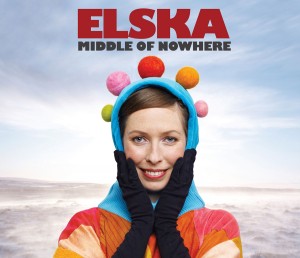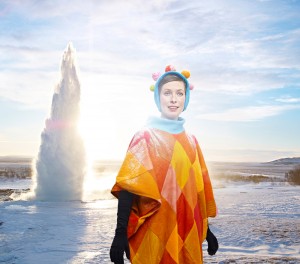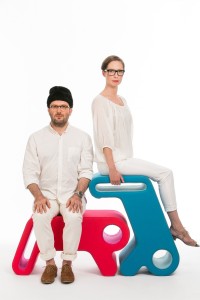Brooklyn Duo Creates Wondrous World of “Elska”
FORT GREENE: There’s something kind of meta about Elska: Middle of Nowhere, a new concept album about an enchanting new children’s character.
Elska – an arctic adventurer who’s discovered a newly formed volcanic island – has a pioneering mind as we learn in the album’s opening song; her story begins with an idea. “It’s so bright and so clear,” she sings, “And it’s totally mine.”
Of course Elska is an idea as well – one that’s been realized by her creators with the same wide-eyed determination you might imagine driving Elska herself. And much like the story of Elska, the story of the making of Elska was an arctic adventure, too.
Brooklyn-based singer/songwriter Shelley Wollert and producer/engineer Allen Farmelo created Elska over, after and between several trips to Iceland. They produced the album at Farmelo’s Brooklyn studio, The Snow Farm, and Mavericks in China Town, and they brought it to life on stages from Littlefield to Symphony Space, and in videos shot in lava fields in Iceland.
When they launched the record this Fall, Elska was already much more than an album.
But it started as an idea… Like their character, Wollert and Farmelo set out on a journey to find their sound. Along the way they had to jettison some of their musical staples to dream up something entirely new. The result is what one critic called “a transcendent work that your young children will hold dear.”
No Pedal Steel Guitars In The Arctic
The aforementioned opening song, “I Just Had An Idea” lays down Elska’s first sonic footprint – a Devo-inspired minimal electronic pop soundscape with clear and close and totally inviting vocals.
Compared to the JAM-packed tween (and really, pre-tween) pop of Katy Perry and Carly Rae Jepsen, Elska’s is a sparse analog pop sound created with Moogs and other analog synthesizers, vibraphone, celeste, music box, and glockenspiel. Developing a unique sonic palette was essential to this project, which aims to bring listeners into a new, “other” world. It shouldn’t sound like it was made in Brooklyn, or in America for that matter.
“If you’re going to make a character who lives on an arctic island with a strange creature called the Goobler, she shouldn’t sound like Hank Williams,” Farmelo says, jokingly but emphatically. Even though they were going for a more Icelandic-inspired modern sound, Wollert’s pre-Elska singing style was more bluesy Americana than Björk. And they were both more likely to pick up a guitar than a Moog.
They had a lot of themselves to shed to get where they were going.
“We had to get it out of the Southwest,” says Farmelo. “We were trying to portray a vast landscape, which is something Sigur Ros (for example) does beautifully. But when I want to portray a vast landscape, I’ll throw a pedal steel over a 1-4-5 chord change and you’re in the desert. There was a moment where that was on an early version of an Elska song, and it sounded like Calexico. And that was not going to work. It’s just that that’s how I know vastness, as an American.”
Ultimately they decided to strip guitars out of the project completely and try to come at “vastness” from another angle. In keeping with the way Farmelo seems to make records anyway, they established some aesthetic guiding principles that would help focus the sound.
“We came up with ‘playful minimalism’,” says Wollert. “I knew I wanted everything from the illustrations to the color palette to the sound, to be clean, clear, organized, fresh and modern. And that’s how we started coming into those words: playful – because it has this imaginative, childlike focus to it, and then minimalism to bring in that modern, fresh soundscape.”
Because “playful” could take you in so many directions, the duo’s sense of “modern” really drove the musical choices. “When you have so many options in front of you, it’s really helpful to have that backbone,” notes Wollert.
And of course they had their more geographically appropriate Icelandic influences. “We definitely borrowed ideas from Iceland – you have things like Valgeir Sigurðsson-and-Björk microbeats on certain tunes, and chimes and malloted bells that are pulled from a lot of Icelandic music. Nothing on the record sounds like Sigur Ros, but we’re using those elements because they’re non-American sounding elements… For us, and the market we’re in, that creates this unique and otherworldly world.”
Then there was Shelley’s vocal – the kind, loving and at times lulling voice of Elska. “Shelley worked day-and-night for months to train herself out of that bluesy, alt-country style,” says Farmelo, “To come at a vocal approach that would match this new music we were doing.”
Alt-country what? There’s barely a trace of it on Middle of Nowhere.
“It was us taking that principle of minimalism and applying it to the vocal,” Wollert says of the process. “We spent a lot of time at the piano, going up five notes, or down five notes, or just practicing one interval from one word to the next without sliding, without scooping up to it.
“I had to whittle it down to simply expressing the notes. And in a sense that’s what made my voice childlike, but at the same time filled with wonder. It’s simple and wondrous.”
And for Allen’s part: “I would do to Shelly’s music what Devo did to ‘Satisfaction’ – square it off, take away swing, syncopation, feel – all of the elements that locate it in a bluesy or funky way, we took all that away from the music. And what’s left is playful and minimal. You get this really bouncy fun, poppy thing. So it’s not that we robbed it of that rhythm, or feel, but we robbed it of those particular rhythms and feels, and particular inflections.”
Moog bass and pocket piano were also key to creating the minimal, yet vast, Middle of Nowhere soundscape. And the guiding principles were also executed in the production, engineering and mixing of the record.
“Most of the drums are done in mono because that narrows the sonic stereofield and gives you a much more minimalist sound,” Farmelo describes. “And, for example, I knew we had to do a crooning approach on her vocal – a very light approach on the mic to get that intimacy. She’s singing very quietly, on the verge of a whisper, but right on the diaphragm of the [Telefunken AK47] mic, and it’s really hot and the preamp is driven in a certain way to bring out that textural quality of her voice. I knew that had to be there to put intimacy into this otherwise very squared off music.”
On the chimey rhythms, Farmelo adds: “I was layering vibraphone, xylophone, celeste, music box, and real glockenspiel, and that was just to get one sound. I found a combination of those things panned out in stereo would create this beautiful three-dimensional tone.”
Engineering Elska
Farmelo is a process-oriented producer/engineer, and though listeners may not recognize it, his production makes Elska: Middle of Nowhere that much more engaging, transporting and – to the little ones who don’t know it yet, and their parents who are starving for it – sophisticated.
“I always think of music as existing as a surface,” Farmelo says. “Some surfaces are convex and point out at you. Some are flat, which is just horrible – when it neither comes out at you nor invites you in. The records that I try to make are concave, where there’s a space there that invites you in. There’s room to move into it. The singing style and the way that we recorded and mixed it is really about making sure that you’re being pulled into the world of Elska.”

Purchase the album at the Island of Elska store.
Middle of Nowhere is both Wollert and Farmelo’s very first foray into children’s music. And rather than researching and pulling reference material, they purposely remained somewhat ignorant to what’s expected.
“I didn’t care that it was a kids album,” says Farmelo. “I just knew it needed to be mixed to sound as beautiful and amazing as any record. In fact I felt even more of a responsibility to make a beautiful record because it’s these fresh young beings who…this might be the first record that certain human beings ever adopt into their lives.
“So I said, this has to be high art, produced as best we can.”
Farmelo mixed Elska on the custom API console he built last year – a console that was inspired in its design by some of the same mid-century modern and Icelandic influences that brought about Elska. A Tape Op contributor, Farmelo has written about his layered approach to record making – a method he refers to as “sonic varnish”.
“Basically, you’re cascading harmonic distortion, EQ and compression over the multiple stages of the recording process, as would have happened in the analog days,” he describes. “ So, we recorded a lot of stuff with EQ and compression happening; and there were no plug-ins used on this record. It was all done on my API console with another layer of EQ and compression on each channel plus bus compression happening there, all mixed down to the Studer [tape machine] in analog.
“So by the end, I had my 12 layers per track of analog processing stacked up. That’s how I get depth and richness and warmth and articulate sounds on records – and that’s how I approached this record as well.”
One thing he was mindful of, considering his audience: “I purposely did not go too heavy on subsonic bass. I think that’s better for kids – it can be heavy, ear-damaging stuff. And that adds an innocence to the music too; since it’s a little lighter on the bass, it twinkles and sparkles a little more. Feels lighter and more open.”
Then, the record actually went to Iceland to be mastered – by Valgeir Sigurðsson, in fact.
“Valgeir was able to add yet another sonic dimension in terms of depth on these mixes – they became even more three dimensional,” says Farmelo. “I’m not sure what exactly he did, but he just knows his gear so well…I think he pushed the circuit of his analog gear to add that one last tiny layer of harmonic distortion. That final layer of varnish on there just added that bit of depth.
“He also did an incredible job of getting it all to hold together from front to back in terms of EQ. It’s what you want a mastering engineer to do: make it sound better, and make it all hold together.”
The Kids Biz – Rolling Out A Kids Record
Though they may have remained purposely in the dark on some aspects of what a kids record should sound like, Wollert and Farmelo did their homework with regard to how to market the record.
“We hired a consultant, Regina Kelland, who has an incredible history and track record working with labels in children’s divisions,” says Farmelo. “I can’t imagine trying to do what we’re doing without her.”
The kids market, after all, is quite different than the mainstream or even indie music business. You have to consider things like “how do you get your music into school libraries? And toy stores?” Wollert points out. “And physical distribution still takes the lion’s share of kids music sales. Kids need to have it in their hands. They don’t understand ‘Mommy just downloaded the record.’ Landing that physical distribution was really important.”
Also key to the project, Wollert is a talented illustrator and graphic designer, and created a physical product well worth owning – including a 16-page color booklet with illustrations of the Elska characters and photography from Iceland. They also were sure to perform in Kindiefest, an industry showcase Farmelo short-hands as the “SXSW of children’s music festivals”, which actually takes place in Brooklyn in the Spring. [It was Elska’s first live performance, and she reportedly blew minds.]
It’s clear that as a business, Elska could take off in so many directions. Wollert and Farmelo also produced a series of music videos with acclaimed stop-motion animator Andy Biddle (The Fantastic Mr. Fox, Wallace & Gromit) and VFX cinematographer Alex Funke (Lord of the Rings, The Hobbit).
“The record is central, but off of that we can see vinyl, video, then merchandise and app development – because it’s a fictional world, it’s just so scalable in so many different directions,” says Farmelo. “It has so many different elements that can be expressed physically, digitally, visually, audibly, even edibly at some point – who knows?”
But the two are cautious about maintaining the integrity of the brand as they consider all the ways Elska can grow.
“I go back to Dr. Seuss and Winnie the Pooh,” says Farmelo of classic reference points. “Winnie the Pooh is a class act. You see that stuff all over the place, but there’s an integrity to those stories and the way Disney’s handled the ownership of that.”
It all comes back to the idea – “so bright and so clear”. And then what you do with it.
“You make a beautiful record. You make videos,” says Wollert. “And then you have to guard it.”
For more on Elska, to watch videos, or to buy the album or Island of Elska merch, visit http://islandofelska.com/.









Andrella
March 27, 2014 at 7:14 pm (11 years ago)for babies- no, but young children, yes!!! I totally fell for this and was drawn into this magical world by the lyrics. The more I listen to it the layered, sparkling instrumentals keep me enchanted. I’m an adult but their is an inner child in me that believes in Elska.